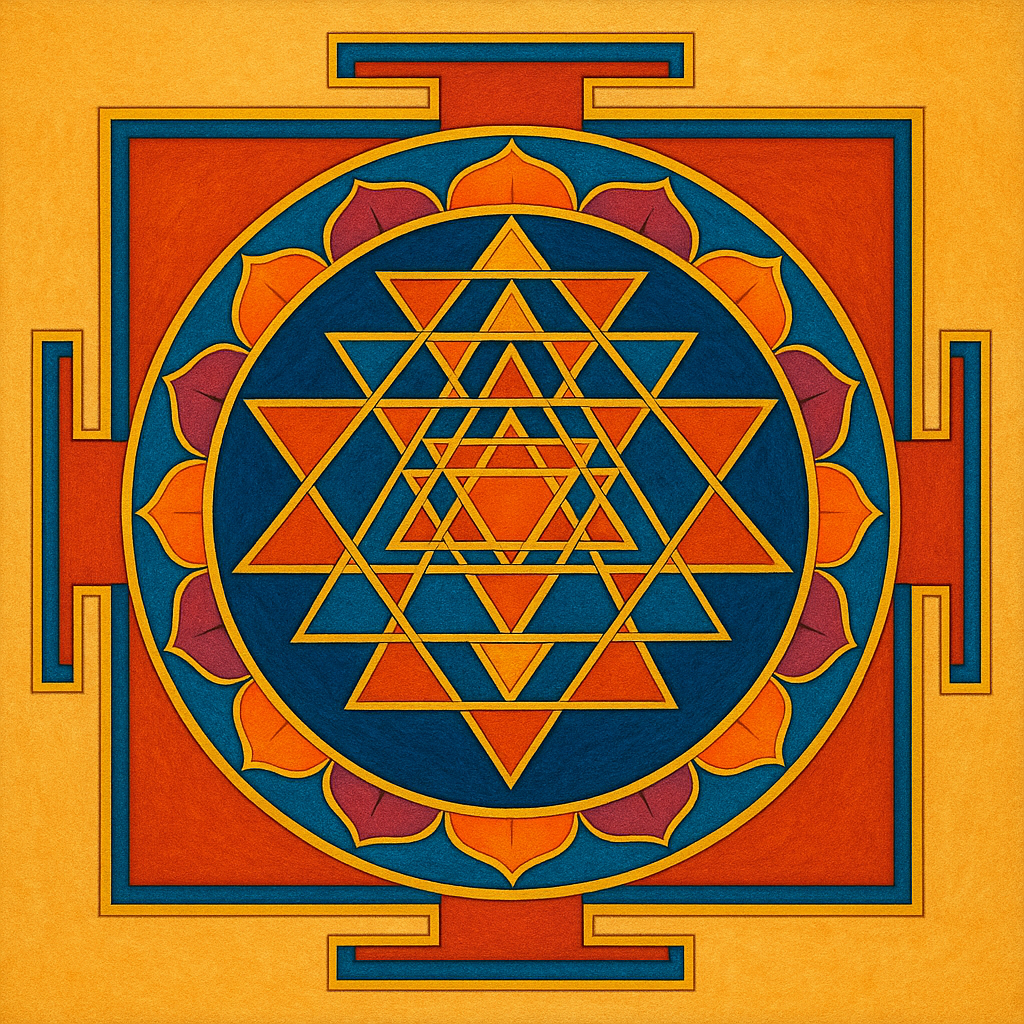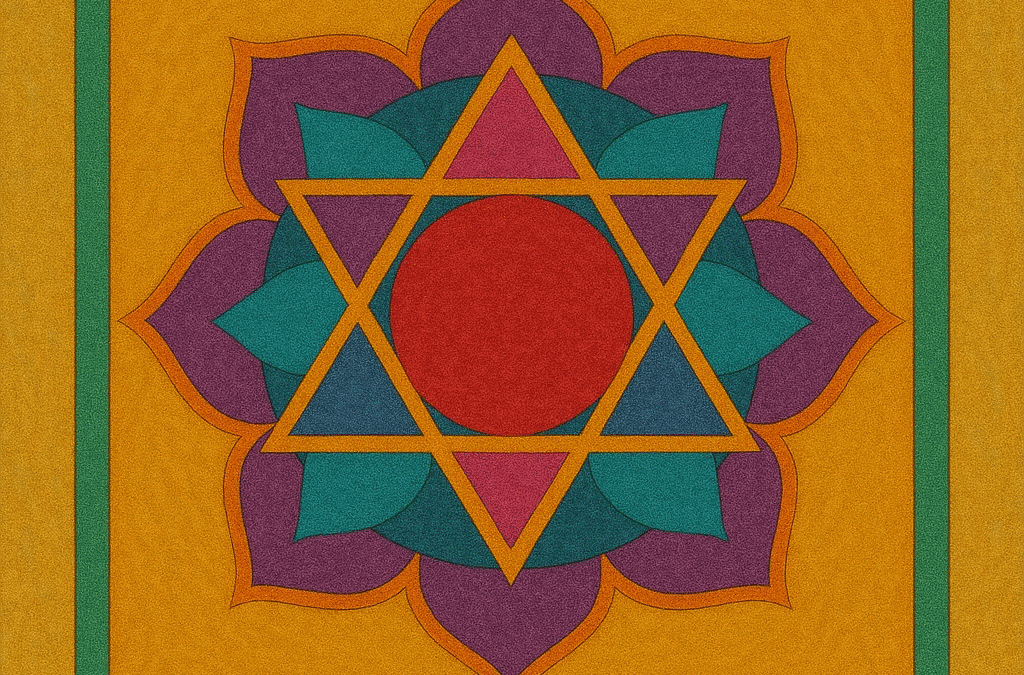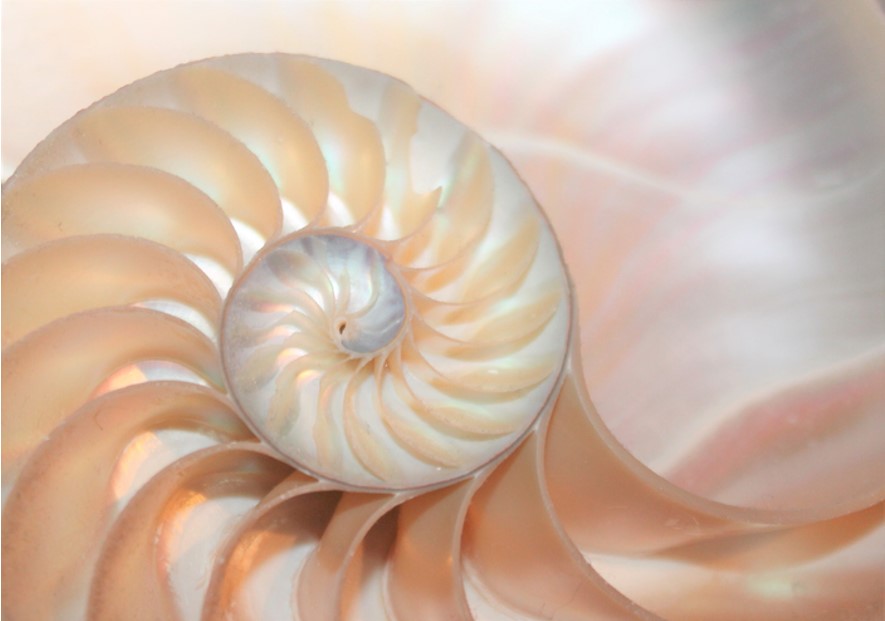Yantra: The Sacred Geometry of Consciousness in Tantra

The True Meaning of Love
August 21, 2025What is a Yantra?
The word yantra comes from the Sanskrit root yam (to hold, to sustain) and tra (instrument or tool). A yantra is thus a “sacred instrument,” a device designed to contain, channel, and concentrate energy. While often depicted as a geometrical diagram on paper, metal, or stone, the essence of yantra is far subtler: it is a pattern that links the human mind to cosmic principles.
Just as a mantra is a vibration of sound that aligns the individual with universal resonance, a yantra is a visual or structural counterpart.Geometry that embodies cosmic truths. Where mantras are shabda brahman (the sonic aspect of the Absolute), yantras are rupa brahman (the form aspect of the Absolute).
Yantra in Tantra
In the Tantric tradition, yantra is not simply art or decoration—it is a living doorway to higher states of consciousness. Tantra, being the science of transformation through direct engagement with energy and form, uses yantras in meditation, ritual, and even in the structuring of physical spaces.
A yantra is both a map and a mirror:
- As a map, it guides the practitioner from the periphery of ordinary awareness toward the center, the bindu—the point of pure consciousness.
- As a mirror, it reflects the inherent order of the cosmos back to the mind, awakening dormant archetypes and harmonizing the psyche.
For example, the Śrī Yantra, the most revered of all yantras, symbolizes the entire manifest universe and the union of Shiva (pure consciousness) and Shakti (primordial energy). Meditating on it, or even being in its presence, gradually reorganizes one’s mental field into greater harmony and clarity.

The Special Significance of Yantras
- Concentration of Mind – The geometric precision of yantras draws the wandering mind into focus. The act of tracing one’s attention from outer forms (lotuses, triangles, squares) toward the bindu induces meditation.
- Embodiment of Archetypes – Each yantra embodies the energy of a specific deity, principle, or cosmic law. For example, the Kali Yantra is stark and fierce, channeling transformative energy; the Durga Yantra embodies protective power.
- Bridge Between Inner and Outer – Yantras are not only symbols but actual energetic blueprints. They are believed to radiate subtle vibrations that influence consciousness and even environments, much like tuning forks set the tone for an orchestra.
- Integration of Sound and Form – Every yantra corresponds to specific mantras. When mantra and yantra are united, the practice becomes exponentially more powerful, activating both the sonic and visual dimensions of the same archetypal energy.
Physical and Psychic Yantras
Most people associate yantras with visible diagrams—etched onto copper plates, drawn in ritual powders, or installed in temples. Yet Tantric philosophy recognizes that yantras exist in both the external and internal realms.
1. Physical Yantras
- Diagrams and Mandalas – The traditional yantras made of intersecting triangles, lotus petals, and concentric circles.
- Architecture – Temples themselves are designed as three-dimensional yantras. Each sanctum, hall, and spire is aligned to cosmic geometry, turning the entire building into a resonant field.
- Sacred Objects and Tools – Even ritual vessels, fire-altars, and dance mudrās are yantras when arranged with awareness.
2. Psychic Yantras
- Yamas and Niyamas – The ethical observances of yoga act as invisible yantras within consciousness. When adhered to, they create subtle geometries of balance and strength, stabilizing the mind like an inner mandala.
- Body Posture and Positioning – How we sit, walk, or arrange ourselves in space forms yantric alignments. The asanas themselves are yantras—geometrical locks that align the physical body with the flow of prāṇa.
- Mental Patterns – Visualizations, archetypal meditations, and even the consistent holding of a noble idea are yantras formed in the psychic field.
In this sense, every deliberate alignment—whether ethical, spatial, or mental—becomes a yantra, shaping consciousness.
Positioning Ourselves in Space
Tantra views the body not as a mere vessel but as a microcosm of the universe. The way we position ourselves in relation to the cardinal directions, elements, or centers of the body creates yantric fields. For instance:
- Facing east in meditation aligns one with the rising sun, symbol of awakening consciousness.
- Arranging ritual space with precise geometry (north-south orientation, altars, fire pits) builds a yantra in which energy circulates harmoniously.
- Sitting in a specific asana stabilizes not only the body but the entire energy system, forming a living yantra with the spine as axis.
Even communities, eco-villages, or temples can be consciously designed as yantras, where the placement of gardens, water, and dwellings forms a sacred mandala in the landscape.
The Living Yantra: Human Being as Mandala
At the deepest level, Tantra teaches that the entire human being is itself a yantra. The chakras are inner lotus-diagrams, the nāḍīs form subtle geometrical networks, and the bindu is the hidden point of transcendence.
When we meditate, chant, breathe consciously, or live by the yamas and niyamas, we are refining our inner yantra, such as removing distortions, balancing energies, and attuning ourselves to the universal pattern.
Thus the purpose of all external yantras is to awaken the recognition of the supreme internal yantra. The Śrī Yantra ultimately mirrors the supreme yantra within—the awakened Self.
Why Yantras are Important
- They hold and concentrate energy, preventing dissipation of spiritual effort.
- They harmonize inner and outer worlds, aligning the practitioner with cosmic order.
- They bridge sound and form, mantra and yantra, leading to holistic transformation.
- They stabilize the mind and environment, making meditation and ritual more potent.
- They reveal the hidden unity of all existence—the bindu where subject and object, self and cosmos, dissolve into one.
Silent Geometries
Yantras are not merely exotic diagrams but sacred technologies of consciousness. They are the silent geometries through which the infinite expresses itself in form. Whether etched in copper, arranged as a temple, embodied as ethical disciplines, or visualized in meditation, yantras serve as stabilizing patterns that align us with the eternal order of life.
To live in awareness is to live yantrically, to recognize that every posture, every act of alignment, every thought of truth, every sacred design is part of a vast mandala in which the universe itself meditates.




